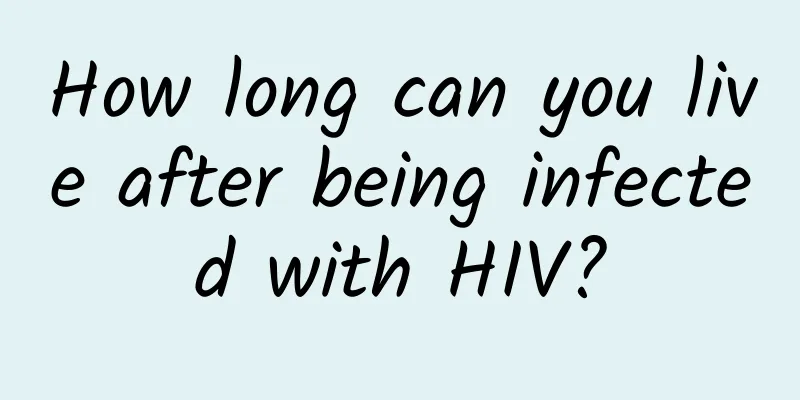How long can you live after being infected with HIV?

|
In May 1980, the World Health Organization announced to the world that humans had successfully eradicated smallpox. In human history, the lethality of smallpox has terrified people, and the eradication of smallpox also means that humans can eliminate an infectious disease through medical technology. So far, humans are very optimistic that more infectious diseases will be eradicated in the future. On June 5, 1981, the Centers for Disease Control and Prevention in the United States announced six cases of Pneumocystis pneumonia, whose immune systems almost completely collapsed, and a new infectious disease came into people's view - it is AIDS. Because of the previous experience of successfully eradicating smallpox, when AIDS appeared, scientists were very optimistic and believed that it would not be long before humans could eradicate this infectious disease. Up to now, 40 years have passed, and scientists have made a lot of efforts, but there is still no medicine or method to cure AIDS, nor an effective vaccine to prevent AIDS. It is precisely because AIDS is incurable that people are afraid of it and stay away from it. Currently, more than 80 million people are infected with HIV worldwide, and more than 35 million people have died from AIDS or AIDS-related diseases. my country discovered the first imported case in 1985. To date, more than 1.2 million people have been infected with HIV, and more than 280,000 people have died from AIDS or AIDS-related diseases. When AIDS was first discovered, many infected people died soon after infection, leaving people with the stereotype that people would die soon after being infected with the HIV virus. Now, how long can one live after being infected with HIV? This is a question that many infected people and the general public are concerned about. Let's discuss this topic seriously. When AIDS was discovered, scientists tried many previous drugs, but unfortunately, no drug was found to have an inhibitory effect on the AIDS virus. In 1987, scientists discovered that the cancer drug AZT (which was abandoned for cancer treatment due to its high toxicity) had an inhibitory effect on HIV, and the U.S. Food and Drug Administration (FDA) quickly approved AZT for the treatment of AIDS. But the good times didn’t last long. Two years later, many infected people developed drug resistance, which again poured cold water on scientists and extinguished the hope of many infected people. Subsequently, scientists accelerated the pace of research, many foundations around the world invested in the field of AIDS research, and more and more new drugs were launched. In 1995, Chinese American scientist David Ho proposed the famous "cocktail therapy" that is still used today - a combination of multiple drugs to avoid drug resistance. Since then, the rate of AIDS drug resistance has become very low, and people no longer have to wait for death after being infected with the AIDS virus. For example, Meng Lin from my country was diagnosed with AIDS in 1995 and is still alive and well. Due to drug supply reasons, my country's initial treatment standard for AIDS was CD4 T+ cells below 200/ul. Later, as drug supply improved, the treatment standard became CD4 T+ cells below 350/ul. Later, the treatment standard was revised to CD4 T+ cells below 500/ul. In 2016, the 21st World AIDS Conference was held in South Africa. Through extensive discussions, scientists attending the conference reached a consensus that AIDS should be “treated as soon as it is discovered” (antiviral treatment should be started immediately after HIV infection is discovered, regardless of the CD4T+ cell value). As long as the infected person follows the doctor's advice and adheres to antiviral treatment, the life expectancy of the infected person is almost the same as that of the uninfected person. After the conference, my country immediately revised its HIV treatment guidelines and implemented the principle of "discovery and treatment". Since then, the treatment rate of HIV in my country has increased significantly. In 2018, my country proposed three "90%" goals for HIV prevention and treatment, namely, 90% of infected people are discovered, 90% of infected people receive antiviral treatment, and 90% of infected people who receive antiviral treatment achieve virological suppression. At present, the latter two goals have been achieved, and the first goal is being achieved. Therefore, I hope everyone will take AIDS seriously. AIDS has changed from a terminal illness to a chronic disease that is preventable, controllable and treatable. In addition to timely treatment, there are some other factors that affect the treatment effect of AIDS: First, compliance. The treatment effect of any disease, not just AIDS, is most closely related to the patient's compliance. In order to avoid side effects of drugs, some patients reduce the dosage or stop taking the drugs privately, which will greatly reduce the treatment effect and greatly increase the drug resistance rate; second, the timing of treatment. Scientific research has found that the reconstruction of the infected person's immune system is inversely proportional to the CD4T+ cell value, that is, the lower the CD4T+ cell value, the more difficult and longer it is for the infected person to rebuild the immune system. Therefore, people who have engaged in high-risk behaviors should go for examination as soon as possible, and start antiviral treatment as soon as possible after discovery; third, the living habits of the infected person. Some patients are accustomed to smoking, drinking and staying up late, which will damage the immune system and counteract the effect of treatment. Summary: After being infected with HIV, as long as you adhere to antiviral treatment and keep a regular schedule, it will basically not affect the life span of the infected person. Although we have done a lot of publicity work to publicize this scientific conclusion, some infected people still do not believe this conclusion and are afraid of dying prematurely from AIDS. I hope everyone will believe in science. At work, I encountered some infected people who stopped taking medication and refused treatment because they were afraid of side effects of the drugs or some side effects of the drugs. This is really regrettable. It is true that AIDS treatment drugs have more or less side effects, but this is related to the tolerance of the infected person. If you really can't tolerate it, you can change the drugs. There are also many drugs and plans for treatment now. Therefore, I hope everyone will face AIDS, prevent AIDS, and actively treat it after being infected with HIV. Dr. Bobo is engaged in AIDS prevention and control work at the Centers for Disease Control and Prevention. If you have any questions about AIDS, you can follow me and send me private messages for consultation. Thank you. |
<<: Is freshly squeezed juice really healthy?
Recommend
How much milk and coffee should you drink together in a day? What is the best way to drink milk and coffee together?
The coffee tree is a perennial evergreen shrub or...
Pueraria root - beautify the skin and protect the liver
The decoction is called "Kugen Decoction&quo...
What should I do if I have mild uterine prolapse?
Uterine prolapse is a disease that seriously thre...
Seven months pregnant abdominal circumference uterine height
Seven months of pregnancy is already the late sta...
Causes of breast tenderness in early pregnancy
After pregnancy, everyone's body changes are ...
36CM mixed echo after medical abortion
Although medical abortion is prone to incomplete ...
How to lose weight on the buttocks for girls
In life, most women love beauty, and many women o...
What to do if you have excessive drooling during early pregnancy
Since pregnancy, due to more or less changes in a...
Causes and symptoms of nosebleeds in girls
Nosebleeds are quite dangerous for many women, es...
What are the precautions for cervical biopsy?
The uterus is a very important organ for women. O...
Can I breastfeed if I have a low fever?
Low-grade fever is a very common illness, which u...
Causes of vulvar itching and yellow leucorrhea
I believe everyone is familiar with the symptoms ...
Pain under right breast
Female breast cancer has a high mortality rate, a...
Can I wash my hair during my period?
We know that women's bodies are relatively we...









